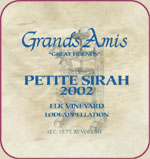 |
|
Wine Details
Price:
$17.99 per bottle
Description:
The 2002 Grands Amis Petite Sirah is a bold wine. The color is purple/red and has an intense depth. The bouquet focuses on raspberry and tart cherry fruit, with nuances of ripe plums and currents. There are hints of a citrus lemon/lime character and black pepper spice. The oak aromas are subtle, and are well integrated. The wine is exceptionally fleshy in the mouth with concentrated grape fruit flavors. The tannins are soft and supple, and the finish is lingering. This full bodied wine is enjoyable now, however, the flavors will continue to "marry" in the bottle, and will be intriguing for years to come.
The wine is composed of 98% petite sirah from the estate's Elk vineyards. These vines were hand nurtured and very low yielding, which led to the intensity of the flavors and tannins in the wine. Two percent of sirah grapes from the same vineyard were added to provide an additional tannin component. Finally, one percent each of carignane and zinfandel, both from the estate's Graffigna vineryard, were blended to complete the fruit profile. The wine was aged for 14 months in older American (40%) and French (60%) oak.
|
|
|